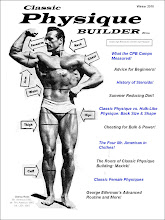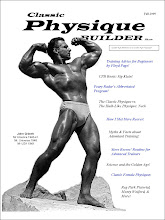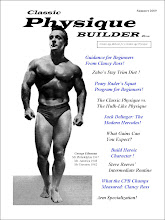 (Photo Above: Classic Physique Builder Champ - Floyd Page, Mr. Pro America 1948)
(Photo Above: Classic Physique Builder Champ - Floyd Page, Mr. Pro America 1948)For those of us interested in building a classic physique, one of our first questions is "What should we weigh and measure?" Usually, if we are young or new at classic physique building, we might find out that some champ we admire, like Steve Reeves or Reg Park, had 18 inch arms and a 50 inch chest. So, we might think that in order to look like them, we too should strive to build 18 inch arms and a 50 inch chest! But, what a minute...not so fast!!! Steve and Reg were over 6 ft tall!
If you are 5 ft 6 in. in height (and are starting out with 12.5 inch arms), you might find it very difficult, if not impossible, to build 18 inch arms naturally! But don't get disappointed! You don't have to have 18 inch arms to have that classic physique look! Instead, you probably only need a 16.5 inch arm! How is that?
Well, this is the good news - classic physique body measurements are proportionate to height, weight, and bone structure! There were many articles in the pre-roid, Golden Age mags (of the 1940s and 50s) which talked about "what you should weight and measure" and they always pointed out that your measurements were dependent on your height, weight, and bone structure.
Now, it is easy to understand that your measurements must be somewhat dependent on your height and weight. It makes sense that if Steve Reeves, at 6 ft 1 in and 215 lbs, had 18 in. arms, then someone 5 ft 6 in. tall, at 175 lbs, might only need a 16.5 inch arm to look proportionately as large as Reeves.
But, height and weight aren't even the full story. There is still "bone structure." In the Golden Age, a common way of looking at bone structure (the size of your bones at a given height) was to classify people as "small-boned", "medium or average-boned", and "large-boned" on the basis of wrist girth (circumference). According to an article by Joe Weider in his Mr. America magazine (March, 1959 issue), if your wrists measure 7 inches or under, then you are "small-boned." If it is between 7 and 7.5 inches, then you are "medium or average-boned." If it is greater than 7.5 inches, then you are "large-boned." Why is this important?
Your bone structure (in addition to height and weight) helps determine what your measurements need to be for a classic physique. Someone with small bone structure doesn't need the same mass as someone with large-bone structure to achieve that classic look!
So, in building a classic physique, absolute measurements aren't important! But relative measurements are (measurements relative to height and bone structure)! In other words, rather than focusing on what Steve Reeves' or Reg Park's absolute measurements are (unless you are as tall as they are and have the same bone structure), you should, instead focus on what your measurements and body weight should be given your height and bone structure! That's why in Classic Physique Builder (CPBzine) we regularly print the measurements of the Golden Age champs - because sooner or later you will find a Golden Age champ of your height and bone structure which will help you visualize what your physique can look like!).
How can you find out "what you should weigh and measure" for a classic physique given your height and bone structure? Well, in the Golden Age mags, tables were commonly printed that gave classic physique measurements at various heights (notice how the modern, steroid-oriented muscle mags don't do this anymore). The measurements in these tables were given for those of "medium or average-bone structure." Then they would tell you to lower (by ~5%) or raise (by ~5%) the body weight and measurements depending on whether you were "small-boned" or "large-boned." In our CPB Courses (once they are available), there will be similar charts showing classic physique measurements at various heights (and taking bone structure into account).
However, if you would like to know right now what your classic physique measurements should be, we recommend Dr. Casey Butt's body calculators at his http://www.weightrainer.net/ site. Casey is a fellow scientist, researcher, academic, classic physique builder, and CPB participant. He did an extensive statistical study of the measurements of the pre-roid, Golden Age champs and drug-free, natural bodybuilders and was able to come up with body calculators that can predict what your classic physique measurements and body weight should be given your height, wrist, and ankle measurement. These body calculators are pretty accurate (since they can predict the Golden Age champs measurements quite closely when their heights, wrist, and ankle measurements are put into them). The description and results of his extensive study are available in his ebook "Your Muscular Potential" - which we highly recommend (especially if you want to see the science behind his approach)!
To get a list of your classic physique measurements, simply click on this link to Casey's body calculator page: www.weightrainer.net/bodycalc.html. On this page, you will find links to two calculators. The top link (Your Muscular Potential) gives you measurements that the typical classic physique builder can expect to achieve. The bottom calculator (Maximum Muscular Potential) gives you measurements that a superior classic physique builder can expect to achieve. So, using these two calculators will give you a good idea of the measurements that you should shoot for in building your classic physique.
Knowing what your classic physique measurements and body weight should be will help you in setting your long term goals. Now, you have a precise target to focus your efforts on! Just don't forget to set appropriate short term goals in order to get you there!
- CPB
P.S. For a free 1 year subscription to Classic Physique Builder (CPBzine) - a pdf zine patterned after the pre-roid, Golden Age muscle mags - just send your name, the name of your city (not your address), state (or province), and country to cpbzine@gmail.com. That's it! Any info you send us is strictly confidential. We don't share info with anyone and you won't get on any lists or recieve any unwanted, automated email (even from us) because of your free subscription!







4 comments:
Nice post. Can you post a list of golden era champs with different bone structures, i.e. small, medium and large. That should help the readers of this blog quite a bit.
Thanks for your posts.
Pratik
Hi Pratik!
Thanks for the feedback! We will think about the best way to do that! It might be best for CPBzine, but we will see if we can do something for CPB Blog as well.
All the best,
CPB (Anthony)
That´s a phantastic article.
Could you give a few more examples on setting short term goals. Would it be more reps, weight etc. ?
Hi Ibrahim,
You are definitely on the right track!
Your long term goals are your classic physique measurements, along with classic definition and aspects of muscular development that can't be measured with a tape measure (e.g., aspects of muscle shape, etc).
Your short terms goals can include the following:
1) monthly measurement goals
2) monthly strength goals
3) each workout's weight goals
4) each workout's rep goals
5) daily diet/nutrition goals
6) daily rest goals
We will talk more about this in CPBzine and our courses, but all long term goals are accomplished by setting up and achieving appropriate short term goals! It is the short term goals that really determines what you do at each of your workouts.
All the best,
CPB (Anthony)
Post a Comment